He has tamed the mighty forces of nature. He was working on a lethal weapon that would bring ... peace. It (un) consciously caused the earthquake, and predicted the production of smartphones almost 100 years ago. Nikola Tesla is probably one of the most underrated inventors of our civilization. Why?
An American engineer of Serbian origin, who has several hundred patents to his credit, is identified with the figure of a genius ahead of his time . Born in 1856, as a child, he was wondering how to control the laws of nature. Suffice it to say that when he was only a few years old he developed an engine based on the design of a small windmill driven by the power of beetles . We also know from the pages of Tesla's autobiographies that among the many mechanical models he was particularly curious about water turbines. The inventor was captured by the descriptions of the Niagara Falls, which, in the opinion of a novice scientist, could become a natural source of energy. It was enough to construct an appropriate power plant system.
Visionary and eccentric
Tesla returned to his childhood idea as an adult. And in fact, at the end of the 19th century, he developed such an innovative system. The development of the electric grid is perhaps one of the greatest inventions of the past century.
Thanks to his photographic memory, which he allegedly inherited from his mother, Tesla was able to absorb the grammar of foreign languages with great ease. He spoke Serbo-Croatian of course, but also Czech, French, Italian, German, Hungarian, English and Latin . He also used a special gift in the world of gambling thanks to which he tried to repair his own finances. During his studies in Austrian Graz, Tesla - coming from a poor family in the village of Smiljan in today's Croatia - could only survive thanks to a scholarship funded by the Military Academy. When the institution was closed, the young scientist was left destitute. To survive, he decided to use his intellect to play cash games . He was especially proficient in pool games, where he quickly turned out to be the best of all participants. As a result, no one wanted to deal with him, and the university did not intend to cooperate with him. Nikola was expelled from university for his reprehensible lifestyle.
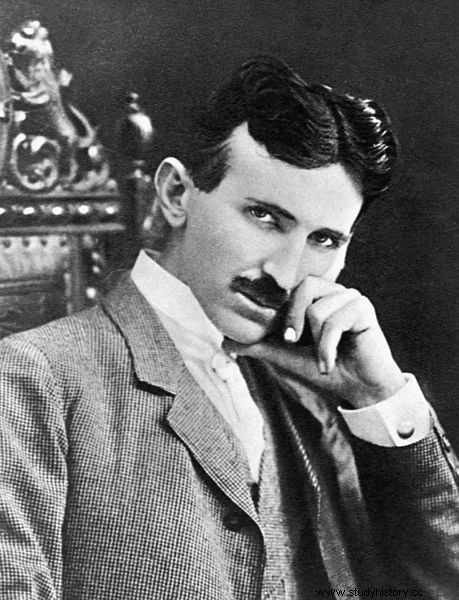
Nikola Tesla - genius and eccentric
Tesla invented patents as a teenager . A revolutionary idea was to build a giant ring over the equator, thanks to which people - attached to a futuristic-looking device - would gain a non-obvious means of transport. The application written in this unusual idea was used decades later, when Tesla's patent came in handy for creating satellites synchronized with the movement of the Earth . One of the boldest ideas were plans to build a system of underwater pipes connecting America and Europe, which would make economic transport possible. In the meantime, however, Tesla found an easier way to travel. In 1884 he decided to move by sea to the USA to make his own "American dream" a reality, which could soon turn into a nightmare. Luggage and money were stolen from a Serbian inventor during a voyage across the Atlantic. And also a ticket, a kind of pass. Fortunately, the genius who immigrated from Europe was able to recreate the number from memory. Thus, the door to the new world was wide open.
Tesla vs. Edison - Electricity Titans Fight
Tesla came to America at the age of 28. He built his natural talent for DIY, knowledge in the field of exact sciences with technical experience, thanks to his work in the Paris branch of the "Continental Edison Company". Tesla was brave and creative which he quickly used as an engineer at Edison's parent company, also an inventor, and by the way - or perhaps above all - an exceptionally effective businessman. It was thanks to him that Tesla learned a valuable lesson, realizing that in science, apart from a flash of genius, also finance, generous funders and patent law count.
The conflict that arose between Edison and Tesla was related to a different concept of supplying cities with electricity - the first of them wanted to use direct current for this purpose, the source of which is even a battery or accumulator, while the second was a great supporter of working with alternating current that would allow the transmission of power over long distances. It must be remembered that at the end of the 19th century the main sources of light were candles or kerosene lamps, and lighting up the world of that time was associated with unlimited profits. And eternal fame.
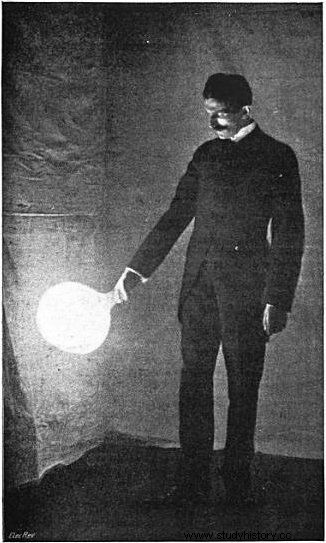
Nikola Tesla has developed, inter alia, fluorescent prototype
There was also a personal clash between the two designers - in the name of principles and interests - when Edison refused to issue Tesla the promised check for $ 50,000. The money was to be a reward for improving the efficiency of the Edison Machine Works factory, especially an improvement to the Edison generator. However, only Nikola, who felt a victim of fraud, quit his job for the famous American. Mutual aversion generated conflict and rivalry. For prestige, money as well as civilization development .
Shortly after parting ways with Edison, that is, in 1886, Tesla decided to create "Tesla Electric Light &Manufacturing" his own company, which he founded with the financial help of Robert Lane and Benjamin Vale. The Serbian constructor - a full-fledged US citizen since 1891 - concentrated on studying the properties and transmission of alternating current. The difficult nature of Tesla, which cared more for private research and social development than for commercial success, resulted in the termination of the cooperation. The real ally in the war with Edison for Tesla turned out to be George Westinghouse, who bought the patents of the young scientist and allowed him to work on the development of projects. One of the most important was winning the tender to electrify the world exhibition in Chicago in 1892, where the miracle of electricity was presented to a million audience for the first time on a large scale.
Tesla made a fortune and did not rest on his laurels . The constructor was thinking about creating a device thanks to which humanity could gain the possibility of trouble-free communication. And although the invention of the radio was initially credited to the accounts of Guglielmo Marconi, an Italian physicist and constructor, later Nobel laureate, in the end - in exactly 1943, a few months after Tesla's death - the US Supreme Court admitted that Marconi based his work on his device on a coil patent high-voltage Tesla. For the Serbian constructor, the legal battle he was waging with his Italian rival was a considerable mental and physical burden. The great genius was not able to deal well with the business side of his discoveries, hence it is often forgotten how great his contribution to the development of science and modern civilization is.
He predicted the rise of smartphones
Tesla's vision was to go beyond the limits - to look confidently into the future. No wonder then that already in 1926 predicted the emergence of wireless devices which will be used not only for communication, but also for data transmission and entertainment. The possibility of free conversation practically unlimited by the place where people are, may have been a futuristic idea during Tesla's lifetime, but today it is a reality.
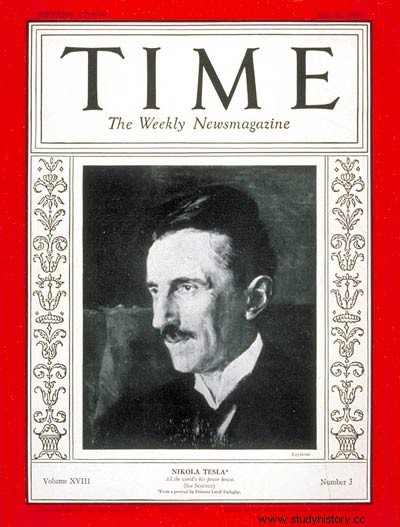
Nikola Tesla on the cover of Time magazine, 1931
The scientist, who in his youth devoted himself to reflection on the forces of nature, as an adult in 1895 with his financial sponsor - George Westinghouse - built the world's first power plant using the power of Niagara Falls . However, the years of development and creative experiments ended with the advent of the great economic crisis, which began in 1929. Tesla's motivation - apart from gaining knowledge, crossing the boundaries of development - was also to make life easier for ordinary people . Introducing a new level for an entire civilization. Hence, when the specter of bankruptcy appeared over the business activities of Westinghouse, Tesla resigned from the fee , believing that his and our human wealth is the future. The inventor paid a considerable price for this generous gesture. Though it was close to being completely forgotten, its legacy is enduring in the best of historical chronicles, scientific achievements, and works of pop culture.
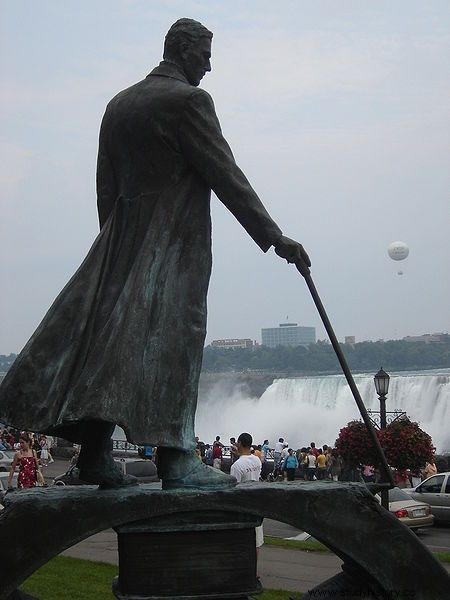
Tesla Monument at Niagara Falls
Continuation of heritage and pop culture memory
Nikola Tesla became famous as an engineer promoting the use of an alternating current generator, the creator of the radio, hydroelectric power plant, autotransformer, bicycle dynamo, as well as the inventor of the electric motor and resonance transformer, thanks to which Tesla can be today called a true lord of lightning . The voltage of millions of generated in this unusual device made it possible to believe that man had really mastered the rules governing the world of powerful elements. It is hardly surprising that the eccentric scientist was believed to have conspire with unclean forces , thanks to which the genius could present the deadly power of electrostatic discharge during his public presentations and lectures.
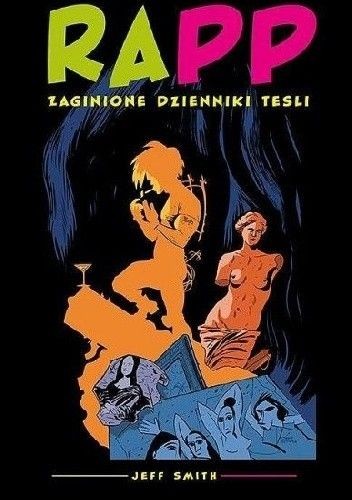
Tesla's scientific achievements could certainly be even more impressive if he were lucky and if his intellectual abilities went hand in hand with entrepreneurial abilities. A real workhorse was also a real eccentric , who with time began to be considered a freak, an anti-social entity that appreciates contact with pigeons more than the company of a human being . Tesla also worked on projects that were astonishing and terrifying at the same time to only bring up a project known as "Teleforce" - a powerful and compact laser, thanks to which the beam of energy released could neutralize enemy armies. Death Ray According to the declaration of Tesla himself, it was supposed to ensure the final peace, because it was a kind of a scarecrow. Tesla's intention was similar to the Nobel philosophy , the creator of dynamite, who believed that work on the development of lethal devices in the military field may make them reluctant to use such weapons in combat practice. As you can see, even the biggest ones can be wrong.
The sometimes futuristic ideas of Nikola Tesla are now being developed by, among others, Elon Musk, a South African entrepreneur who oversees the company "Tesla Inc.", where intensive work has been carried out for years on the development of the car industry charged with electricity. The first copies from the assembly line rolled off in 2016, now modifications are being introduced, which the innovator from Serbia thought about in the last century.
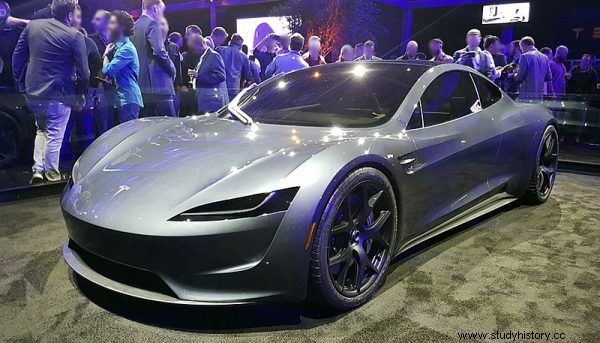
Tesla roadster, prototype 2020
Tesla's achievements in life, as well as simply elements from a fascinating biography of an engineer, have become a matter that both historians and specialists in various fields of technical sciences, as well as artists, deal with. His legacy is the subject of a series of documentary programs and popular science publications. and artistic stories. Tesla, as interpreted by David Bowie, was at least one of the heroes of the spectacular film "Prestige" directed by Christopher Nolan, he also appeared in the monumental novel "Ice" by Jacek Dukaj, he was also devoted to the extraordinary comic series "Three Tesla ghosts", as well as the album "RAPP. Tesla's Lost Journals. The title of the last work is also special, because it is worth knowing that he spent the last years of his life like a hermit, remaining in philosophical seclusion, and the mysterious death was also associated with an open safe in which the scientist stored his encrypted plans, as many years later we learned from the FBI report. Tesla, however, lives symbolically - as a hero of pop culture and patron of science - proving that it is possible to become truly immortal.
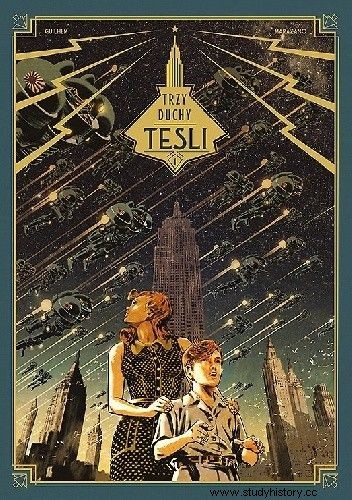
Bibliography:
- Nikola Tesla, My inventions. Autobiography, Kucharski Publishing House, 2017
- Przemysła Słowiński, Krzysztof K. Słowiński, Nikola Tesla. The Thunder Lord, 2018
- Ken Beauchamp, History of telegraphy , Institution of Electrical Engineers, London 2001.
- Margaret Cheney, Robert Uth, Tesla:Master of Lightning , New York 1999.
- J. J. Fahie, A history of wireless telegraphy , Edinburgh 1901.
- Andrzej Kajetan Wróblewski, History of Physics. From the earliest times to the present day , PWN, Warsaw 2006
